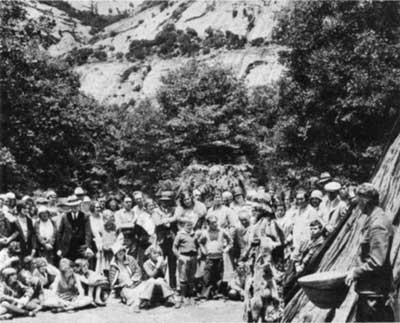THE NATIONAL PARKS AND EMERGENCY CONSERVATION
EDUCATIONAL USES
As has already been indicated, the national parks and national monuments offer exceptional opportunities for informal education. The education afforded in these areas is not the kind that is acquired in schools or from textbooks. Rather, the city dweller in the parks has an opportunity to acquire, under the leadership of ranger naturalists, information about trees and plants that all skilled woodsmen know almost as second nature. The person untrained in the sciences, seeing a great work of nature such as the Grand Canyon, takes a brief course in popular geology when he inquires of the naturalist as to just how the great gorge came into existence, how long it was in the making, and why the banded colorings. So with the Yellowstone geyser fields. "What makes the geysers geyze?" is a popular question; "Do the geysers freeze in winter?" is another, and so on. In the Yosemite, seeing great Half Dome towering nearly 5,000 feet above the valley, the natural impulse is to ask what happened to the other half; and here again is a brief lesson in geology.
In other words, the educational service in the national parks and monuments is a definite outgrowth of the demands of visitors for information as to the why and wherefore of the interesting and unusual things encountered along the beaten track or out-of-the-way trail.

An Indian Dancer at Yosemite
This demand for knowledge is met primarily in two ways–through the ranger naturalist service and through the museums. The ranger naturalists are men and women trained in the sciences and in public contacts. They conduct parties out on the park trails on short or long trips and give informal talks at the camp fires in the public auto camps, in the lodge and hotel lobbies, and in the museums.
The museums in the parks are designed primarily to interest the average visitor in finding out for himself just what the park has to offer. It has been said that the museum exhibits are in reality only the index to the park itself; which is the real museum of nature.
In the prehistoric monuments, of course, the museum exhibits are different. There one sees on display the implements in use a thousand years ago in grinding corn, and other ordinary routine of life-a sandal or other bit of clothing or personal adornment, and shreds of baskets, and pottery of many designs and colors.
We call visiting one of these prehistoric exhibits an educational proceeding or a study in archeology, but really it is just getting a little first-hand information as to how our neighbors of many centuries ago lived. And we find ourselves quite as curious about them as we are about our next-door neighbors.
Top
Last Modified: Tues, May 23 2000 09:38:48 am PDT
http://www.cr.nps.gov/history/online_books/ecw/ecw7.htm
![]()

